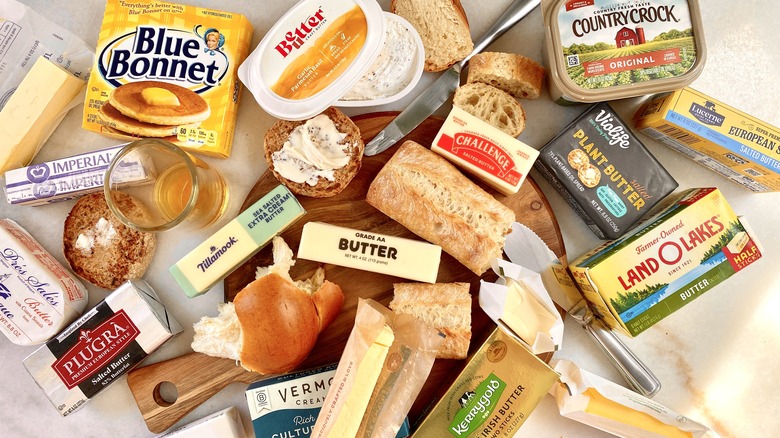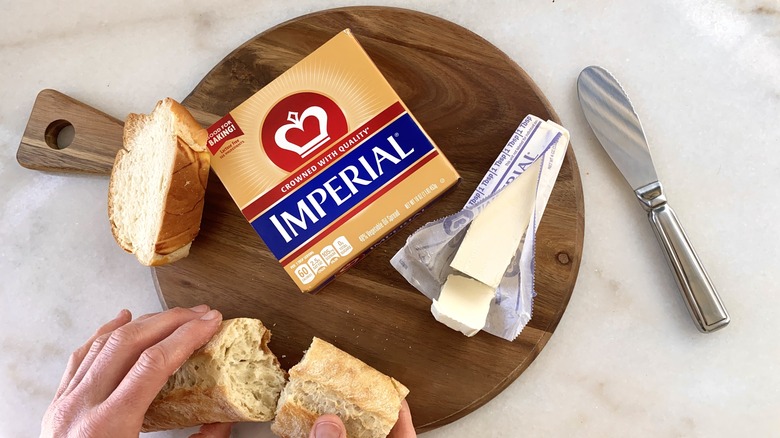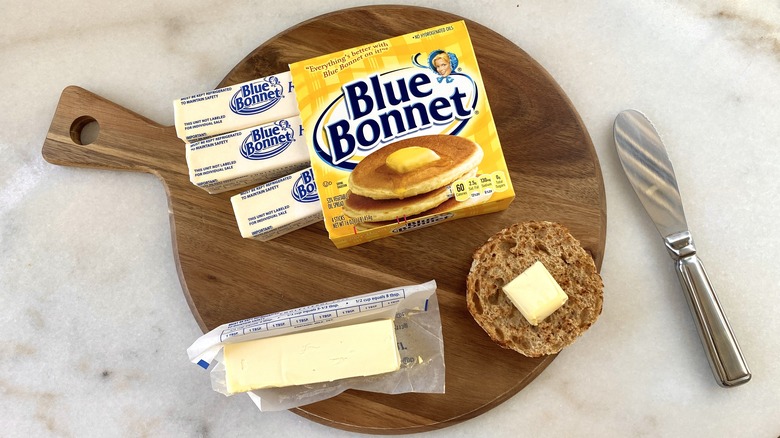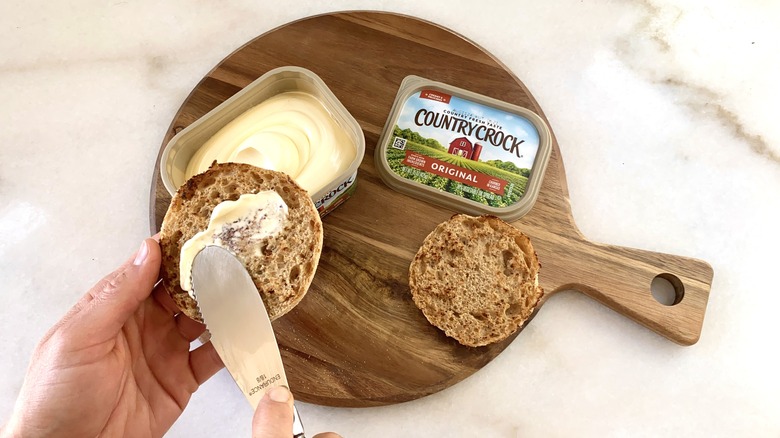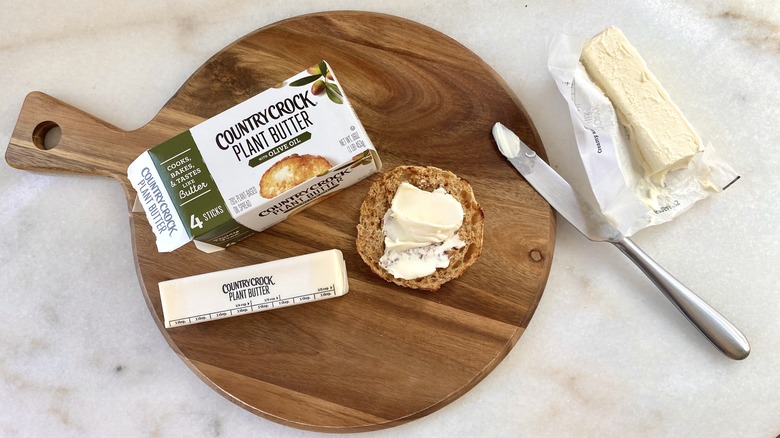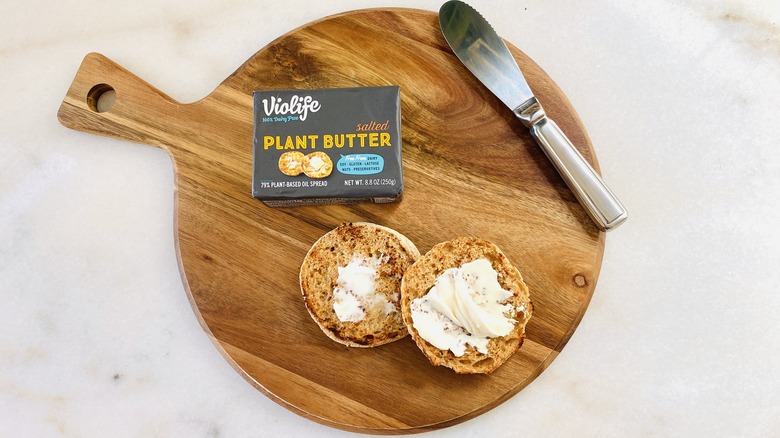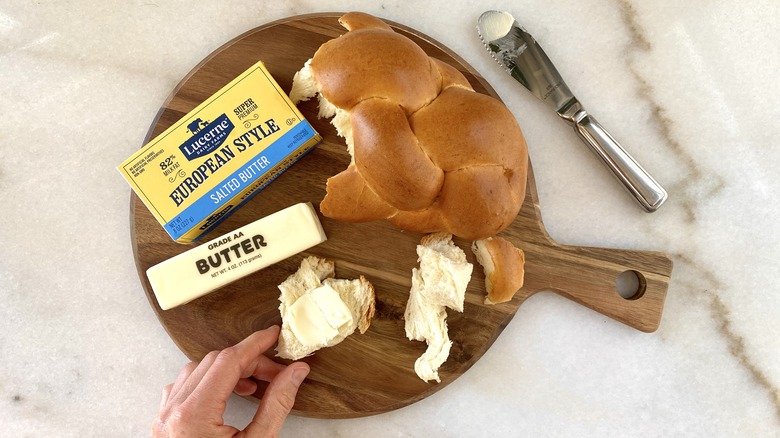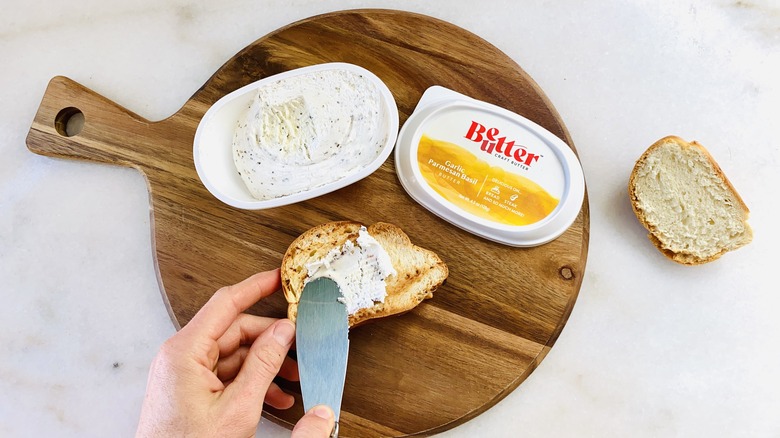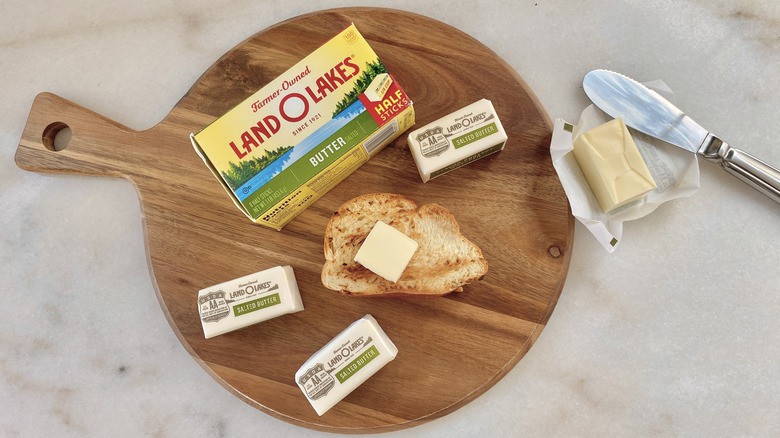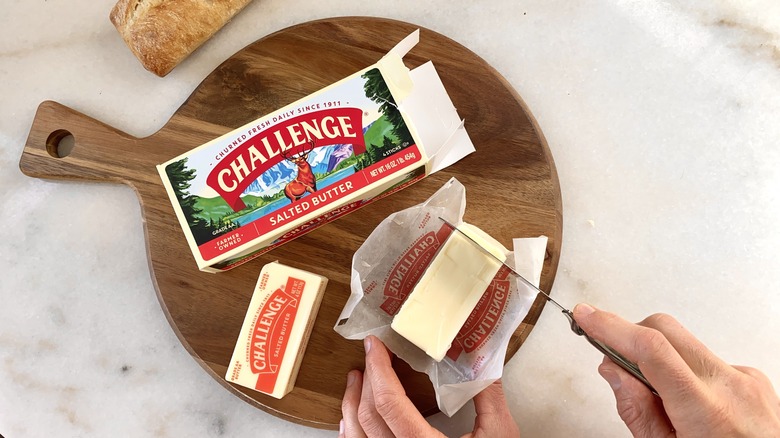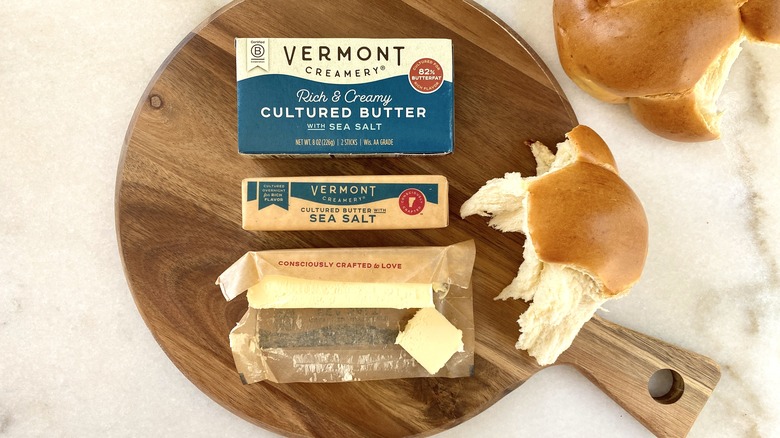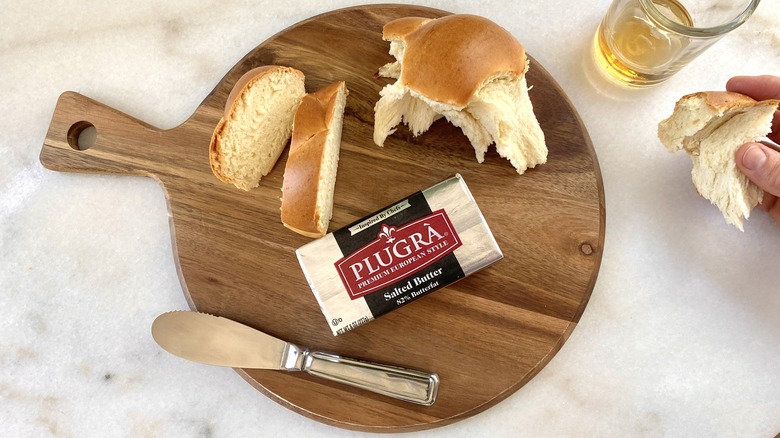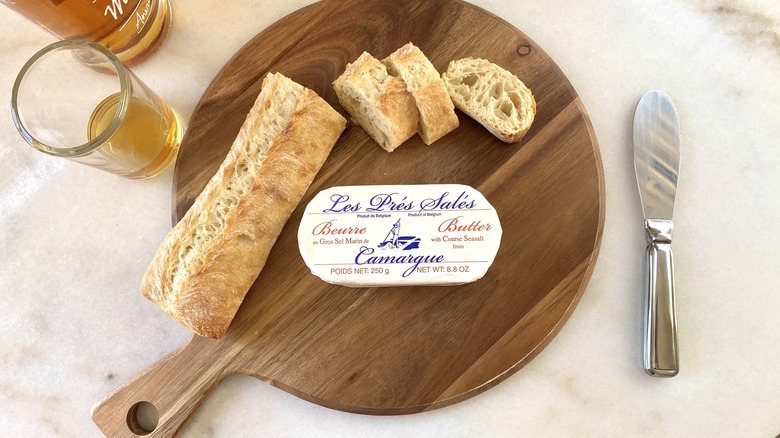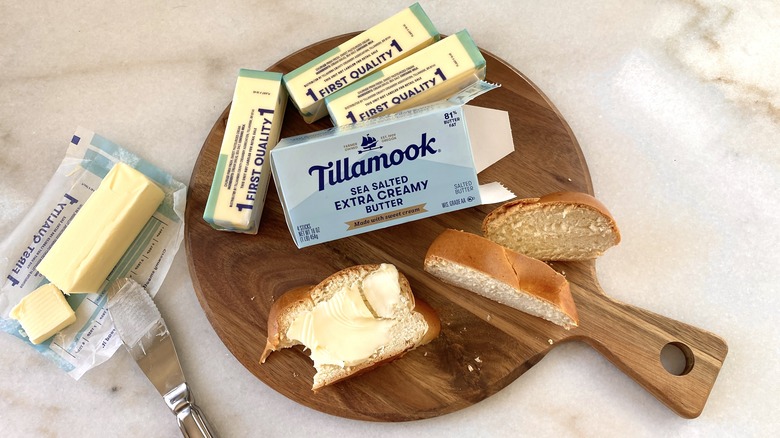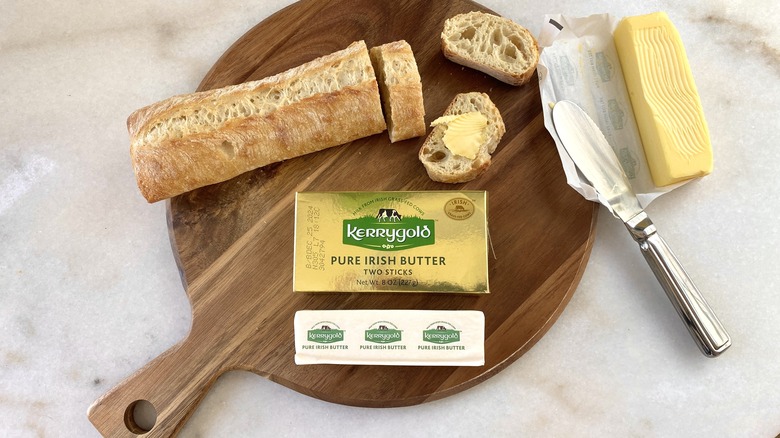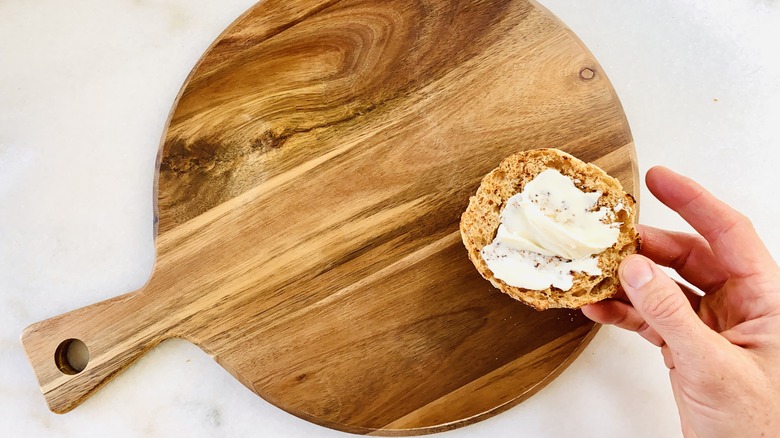14 Store-Bought Butter Brands Ranked From Worst To Best
You could always go with your same old butter brand. But if you really want to mix up your sticks — and finally live your butteriest dreams — we ranked America's favorite store-bought butter brands from worst to first. (Trust us, No. 1 is solid gold.)
Whether you're Marge who loves a spreadable margarine, or Mr. Clancy who prefers it a little more plants-y, we dug deep and tasted vegan varieties, as well as lower-fat options just for you. But, for those who like fresh cream, hold on to your baguettes. We churned up some seriously well-cultured and salted contenders that demand to be tasted.
From American-style sweet cream varieties, to European-style brands, and Irish grass-fed cows' milk butter — along with the magical world of margarine — which brand will really butter your biscuit? And which one won't? We patted and slathered our way to a winner that (ahem) smeared the competition.
14. Imperial spread
Kicking things off with the least tasty brand of the bunch, Imperial vegetable oil spread is the slightly more expensive cousin of Blue Bonnet margarine. Except, despite its somewhat higher price point, it is completely flavorless. (Hello, ever heard of a pinch of salt?)
Since margarine often fills in where dairy cream-based butter would, in cooking and baking, we're including margarine on our list. Imperial spread is lighter in color than Blue Bonnet — which could signal an elevation in gourmet status — but, instead, it appears as if the sunshine has left its body. It also creepily keeps its shape no matter the environment. (It sat on the counter forever, and yet it looked like it came straight out of the fridge.)
In what appears to be a classic margarine brand move, Imperial lists a chocolate chip cookie recipe on the back of the box, possibly to give the illusion that this is real food that should be ingested by actual humans. Make no mistake. It is not. (P.S., butter — or margarine — shouldn't be the only fat you use when making cookies.)
13. Blue Bonnet
If you grew up in the '80s or '90s, you might remember Blue Bonnet and Country Crock as the titans of "butter spreads" in your life. A convenient condiment that found its demo after WWII for being lower in fat, a hefty tub of margarine in the fridge was life.
Fast forwarding to today, the "buttery taste" of Blue Bonnet hasn't changed much. The spread features less fat and calories than butter, but with lots of extra preservatives and additives. (Butter is usually made of cream and salt). But that's not the creepy part.
After spending hours on the kitchen counter as part of this testing, the Blue Bonnet stick looked like a perfect yellow statue of butter, keeping its sharp-edged rectangular shape, with zero softening. It tasted slightly salty, but after that, it tasted like nothing — as if it was dreaming of one day having a flavor that someone remembers. At $1.79, it's the cheapest brand on our list. But when it comes to butter — or any imposters — you get what you pay for.
12. Country Crock Original
Full disclosure: This writer grew up on Country Crock. But the throwback flavor didn't tug on any heartstrings. While it's unclear what "Country Fresh Taste" the packaging is referencing, the Country Crock Original vibe feels more like it's fresh out of a food desert.
Let's take a look at those so-called farm fresh ingredients. Based on the official nutrition label rundown, we're guessing the closest thing there is to farm-related anything, are the original soybeans that were used to make the soybean oil.
While it definitely tastes like a variety of butter, don't leave it out on the counter too long. As was quickly discovered during taste-testing, it turns into a weirdly gelatinous mayo-type situation not even resembling butter anymore. Yes, it's slightly better packaged than other margarines on the market. But it tastes only as good as margarine may ever taste for all of eternity. That buttery glass ceiling lands it right here on our list.
11. Country Crock plant butter with olive oil
On the surface, this seems like Country Crock's reboot for the plant-based crowd. But when you remember that Country Crock Original is made with soybean oil, the newer Country Crock Plant Butter which also features soybean oil (It has olive oil, too, you guys!) isn't that impressive.
Even worse is the fact that it tastes like flavorless nothing. If the ingredient list is anything to go by, there is less olive oil in this blend than there are palm and canola oils. Still, how is it possible that all these oils make up a plant butter that has zero flavor?
This stuff might work for those watching their fats (It's got 25% saturated fat, where dairy butter has 35% of your recommended daily saturated fats), or for anyone skipping the dairy (No cows' milk here). But for those of us actively trying to limit our intake of flavorless butters, this ranks pretty high on the hog — and in the bottom four on the list.
10. Violife salted plant butter
Vegans, this is not a drill. Violife Plant Butter has zero dairy, but it actually tastes delicious. It's also not margarine, which can technically utilize dairy in the manufacturing process. Nope! This is the real non-dairy deal. Finally, you can butter your bread with plant-based confidence.
Coconut oil, canola, and sunflower oils somehow all work together to create something that looks and eats like butter. Unlike all the previous attempts at butter alternatives on this list, the flavor is flawlessly savory and decadent. It also functions just like butter does — it works for baking blueberry muffins, melting and tossing rice crispy treat mixes, and it sautés and drizzles like the real thing.
It lands toward the middle of the pile despite the fact that it's a total winner for the vegan and lactose-free crowd. When we originally thought of the best butter, we wanted the greatest grocery store brand we could find. And that, friends, happens to require a few good cows.
9. Lucerne Dairy Farms European style salted butter
Taste the flavors of Europe from the comfort of Pleasanton, California. The name Lucerne alludes to brown cows with long bangs, jingling their bells somewhere in the Swiss Alps. But Lucerne Foods is actually a Safeway subsidiary, which explains the California part, since that's where Safeway is headquartered.
The style, however, is happily European, with a higher milk fat content at 82%. It's savory in flavor, and salty too. But despite its super premium styling, it feels a little light in the luxury department. Does it need more salt? More cream? Some kind of aging process to add a zippy tang? On a scale of one to 10, it's an undecided five, landing neither here nor there in any one category. If this is the salted version, we can only assume that unsalted would be unpalatable — except if hidden in a really awesome cookie recipe!
Lucerne gets points for being real butter. But we think the brand could have gone for a stronger (ahem, butterier) statement.
8. Better Butter garlic parmesan basil butter
Okay, full acknowledgement of the fact that adding garlic, parmesan, and basil to anything will certainly make it stand out. But Better Butter garlic parmesan basil butter — go ahead, say that five times fast — offers more than its drool-worthy seasoning.
At first blush, you'll notice that it's speckled with what appears to be dried garlic and basil — tasting like it's two ingredients away from being everything bagel seasoning. It also features an unexpected fluffiness, like whipped cream cheese. Salty garlic hits your taste buds with a karate kick, while the parmesan cheese is more of a vibe than a distinguishable flavor. Maybe it finds its way onto the scene as a lingering aftertaste.
Fun fact: You can keep Better Butter on the counter for six weeks. This is thanks to the fact that salted butter is safer to leave on the counter than unsalted. (Not that it would ever last anywhere near that long among flavored butter lovers.) It lands here because, while it's a winner, the garlic that has yet to vacate the premises guarantees that we won't be getting close to any human people in the foreseeable future.
7. Land O Lakes salted butter
Major props for the half sticks. If you love baking, you'll appreciate Land O Lakes Salted Butter's perfectly portioned packages, ready to peel open and use all at once, or stay neatly organized for next time.
Land O Lakes is a co-op owned by farmers who clearly care about quality. (No offense, margarine.) Unlike the other stuff, it's made with just two ingredients: sweet cream and salt. How is sweet cream butter different than standard cream? Sweet cream is a staple of American style butters, made from the pasteurized cream (not cultured cream) that comes from fresh milk.
Here, you'll find a velvety texture, with a light, almost white-colored butter. The flavor is well-balanced and feels salted, but not salty. So it goes well with just about anything from a crusty baguette, to pancakes, caramelized veggies, and rich pastas. It's wonderfully middle of the road — and middle of this list.
6. Challenge salted butter
This packaging makes no sense until you know that the Challenge name comes from a mural of two elk, called "The Challenge," that the original brand president saw as the mission for his company: Challenge versus the rest of the butter industry. It was the 1911 version of "Bring It On." And it was definitely "brought-en."
This farmer-owned business started out as a creamery co-op back in the day. Now, nearly 5 million people eat a pound of Challenge butter every week. That's probably because, like Land O Lakes, and Lucerne Dairy butters, this brand plays well with just about any recipe you could possibly dream of cooking. Made of sweet cream and salt — and nothing else — Challenge salted butter offers a deliciously smooth and savory flavor.
It's a really strong contender for the category of Best Basic Butter. In the world of butter, simple, high-quality ingredients make up the best of the bunch.
5. Vermont Creamery cultured butter
Vermont Creamery cultured butter already looks legit with its parchment paper-style wrappers and the fact that it's from Vermont where other delicious things come from (Maple syrup, apples, cheese, craft beer, etc.). But, unlike the other butters on this list, this brand is cultured. Just like you try to be on Instagram.
The process involves adding live bacterial cultures to pasteurized cream, and letting it rest in large vats to "culture" and deepen in flavor. (So it tastes like tangy buttermilk with hints of toasted hazelnuts. Is cultured butter your new favorite food or what?) This unique flavor profile distinguishes it from American-style sweet cream butters. Once fermentation is complete, the mix is then churned, which is when it gets its insanely velvety texture.
This one spreads like a dream at room temp, and tastes like smooth, creamy sea salt magic. (Perhaps it's an appropriate moment for an ode to cultured butter and things to smear it on.)
4. Plugrà premium European style salted butter
Well, the look certainly isn't selling it. But despite its generic foil-like packaging, Plugrà premium European style salted butter unwraps to reveal a pro-level flavor that's definitely worth tasting.
The brand caters to the professional kitchen, so we're lucky they marketed a line for us noobs browsing the dairy aisle of our local grocery store. The main plug from Plugrà is that it's created and inspired by chefs, with the notion that whatever you cook will turn out flawlessly — because chefs. (Gotta say, the Plugrà butter on challah situation was a chef's kiss.)
With European-style 82% butterfat content, it's a versatile ingredient for any recipe. (This salted style works best for savory dishes; Unsalted, for sweet). On its own, its delicate light yellow color gives way to a creamy oiliness that coats your throat and sticks around for a little while. (Is this where we recommend a bit of wine to cleanse the palate?)
3. Les Prés Salés Camargue coarse sea salt butter
If you happen to miss the sea salt description on the label, you will confront its flavor face-first in this epicurean masterpiece from Les Prés Salés — "the salt meadows" of Camargue, in the south of France. With the petit salt on hand, the butter is manufactured in Belgium, from the milk of cows who have grazed the Belgian Ardennes. Sigh. Would you dream of salted butter from anywhere else? (Get to the eating!)
Similar to the Kerrygold brand in its sunshiney hue, this butter appears almost marbled or veined when you cut into it, flecked with coarse bits of visible sea salt. (Or the buttery tears of melancholy French unicorns.) The flavor is unmistakably piquant, which begs, "Is this too salty?" and also doesn't stop you from slathering on more.
Les Prés Salés Camargue coarse sea salt butter lands in third position purely for the fact that the salt is the star, with the exquisite cows' milk cream playing second fiddle to the French export. Still, that coastal flavor is also what makes it taste so freakin' good.
2. Tillamook sea salted extra creamy butter
Right off the top, you know this is real butter because Tillamook skipped the obligatory cookie recipe and suggested a saffron lemon and white pepper compound butter recipe on the back of the box. (Suggested pairings: Dungeness crab, oysters, artisan bread ... you get the picture.)
Coming in just shy of first place, Tillamook sea salted extra creamy butter packs 81% butterfat content, which puts it in an American-style-plus category, but not quite fatty enough to make it European style butter. That's okay. It's made in Tillamook, Oregon, after all. Apparently 81% butterfat is officially Oregonian. The taste of ultra decadence — seriously, is this technically cheese? — comes from a company that's been farmer-owned since 1909, and is all about respecting the cows who make it happen.
This variety is supremely creamy with a saltiness that complements the smooth jazziness of the texture. Not to horn in on marketing, but maybe it should be draped in velvet and pearls. Except it's Oregon, so zip-up fleece and tattoos, maybe?
1. Kerrygold pure Irish butter
We've seen the end of the rainbow, and that lucky pot is filled with pure, Irish Kerrygold. Easily sweeping the competition, Kerrygold pure Irish butter slid into first place, as smooth as ... silk. (Yes, okay — butter.)
You almost need SPF to bask in the golden-hued glow that comes from the milk of cows who eat beta-carotene-packed Irish grasses. You'll taste a creamy, savory, mildly salty flavor right at the jump. At room-temp, it spreads like a velvety dream. Just go with it if you smile like a complete weirdo when this butter melts on your tongue. It's probably the most bang for your buck butter you can get at a regular grocery store in Anywhere USA. It's great for a pat, a dip, a schmear, or a glaze. And, according to some chefs, it's the best butter for making cookies. Nobody's mad about that.
It's the most well-rounded butter on our list, relying solely on quality ingredients that blend flawlessly in order dominate the competition, versus seasonings or an extra dose of salt. So does the winningest spot go to Kerrygold just for their happy cows raised on small, happy family farms? Well, those cows are "out standing" in their field.
Buttery credentials
Obviously, this is not a complete list of all the different kinds of butter you could possibly find in the world. But it is, indeed, a solid cross-section of the brands I could source from my local grocery store in Los Angeles. Hopefully you can find the same brands near you, if they catch your eye! (Sorry, oddly specific $14 Amish butter — you didn't make the cut this time.)
Having grown up in Pennsylvania, with a best friend who lived on a dairy farm, I have tasted my share of different butters, eaten butter-based foods, and invented snacks that didn't even need butter. (Now we put it in coffee!) I appreciate a decadent salty fat as part of a balanced meal, and will fight you for the last warm dinner roll — because that means more butter. I sourced my many buttery talents for this ranking. And you are welcome.
Of course, along with our crème de la crème, we wouldn't be worth our salt unless we also made sure to scoop up the same butter Ina Garten always keeps stocked in her fridge.

